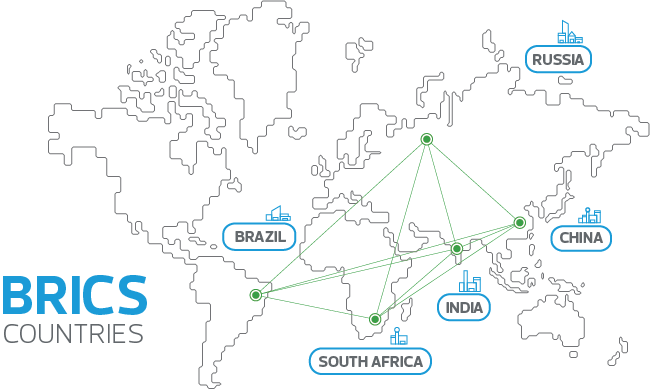Any globalisation definition should include more than just the ever-expanding technological advances in transport and communications. It is instead about decreasing obstacles to international trade and investment, increasing global supply chains and improving macroeconomic coordination among the world’s top economic players, especially those member countries of the G20. These are considered to be the most common benefits of globalisation and answers the question: what is globalisation?
Other advantages of globalisation can be found in the common and shared ways of experiencing the world, which help interdependence and interconnectedness – the basis for productivity gains on a global scale and the sustained expansion of the world economy over time.
All of these globalisation examples seem to have been clearly in check for the past seven years, particularly the globalisation of values – the notion of a normative compass found in the 1990s idea that the principles of a market economy and representative democracy as a system of government were the best parameters for the organisation of societies across the globe, which helped both the wealth creation and the rise of developing nations.

The concept of ‘emerging markets’ came up years ago as a driver of the future of the world and a sign that the impact of globalisation was successful. Demographics, territorial scale, low production costs, easy access to commodities – all were signs of impending change in the geoeconomic axis. Countries such as the BRICS (Brazil, Russia, India China and South Africa) became the world’s ‘engines of growth’. Export-driven growth in China, a ‘transition economy’ for Russia’s market, outsourcing and technological innovation in India, and ‘import substitution 2.0’ in Brazil kept these economies booming – and social tensions quelled.
 These economies successfully adapted to the ‘deep globalisation’ which gained steam with the end of the Cold War. This ‘hyper-globalisation’ was guided by the values of the market economy and representative democracy, the prominence of the U.S., the rise of Asia headed by Japan and the logic of regional economic and political integration.
These economies successfully adapted to the ‘deep globalisation’ which gained steam with the end of the Cold War. This ‘hyper-globalisation’ was guided by the values of the market economy and representative democracy, the prominence of the U.S., the rise of Asia headed by Japan and the logic of regional economic and political integration.
With the fall of Lehman Brothers in 2008 and the beginning of the ‘Great Recession’, the mood has changed and we are now running a ‘risk of deglobalisation’ — of which Brexit and Trump's ‘America First’ are clear examples — where countries and companies restructure their strategies into protectionist and individualistic actions, reacting to perceived disadvantages of globalisation.
In the ‘deglobalisation mode’ we now face, we are confronted by ‘multiplatform’ conflicts and tensions (viral terrorism, across-the-board criticism of the West and its liberal political and economic order, cyber-vandalism). Instead of the ‘end of history’, we observe the emergence of ‘multi-histories’. In such a context, we find the U.S. in serious doubt as to its role in global affairs, with policy makers weighing up the advantages and disadvantages of globalisation. Consequently, the U.S. seems more inclined to focus on its domestic issues and more reticent to play the part of leading global force for what it perceives as democracy and free markets.
Geoeconomically, focusing our globalisation definition by geography, we continue to watch the rise of Asia — unmistakably led by China. But we are also experiencing a slower, less deep pace in regional integration and the revival of the nation-state as the leading player in global economic affairs. In this context, international relations (understood here as relations involving nation-states) have resurfaced powerfully. It is not necessarily a world of renewed nationalisms, but rather a global juncture in which nation-states are particularly selfish, individualistic, acting according to an ‘every-nation-for-itself’ mode.
Reglobalisation will be more ‘superficial’ than the idealised ‘end of history’ world order we might have experienced at some point since the Cold War. It will be mostly focused on trade, investment and the strengthening of global production networks.
When those pro-convergence drivers made available by ‘deep globalisation’ changed course, the honeymoon with emerging markets apparently came to an end. Their economies have been slowing down. This has taken a toll on the outlook for the direction of international capital flows. But this supposed ‘end of the affair’ with emerging markets has taken many to rush to superficial conclusions: no more talk of convergence or decoupling. It is as if deglobalisation and a return to the old ‘North-South’ economic hierarchy are here to stay.
In reality, performance in the coming years will be judged less by what we today label either ‘advanced’ or ‘emerging’ economies and more by a country’s ability to competitively shape up to a ‘reglobalisation’ now in the making.
Reglobalisation, the new age in world affairs we are stepping into, does not promote the verticalisation of cross-border dynamics of regional economic, political and legal integration. Regional entities will not take precedence over nations as the main actors in global affairs. It will not bring about a far-reaching communion of different world views. It will not come under a new global compact stitched together at the United Nations or the World Trade Organisation.
Reglobalisation will be more ‘superficial’ than the idealised ‘end of history’ world order we might have experienced at some point since the Cold War. It will be mostly focused on trade, investment and the strengthening of global production networks. It will also be more selective – and therefore emerge as the result of the proliferation of multiple free trade agreements at bilateral level and between some of the most powerful economic regions in a post-Trump world.
Deglobalisation will hurt everyone, and especially those countries — such as the U.S. — which have used the global footprint of its multinational corporations as a competitive advantage. That is why deglobalisation should be short-lived. Reglobalisation will gain traction when negotiations involving the U.S and Europe resume – such as the so-called Transatlantic Trade and Investment Partnership. Similar dynamics should soon be observed in a process involving the U.S and other countries bordering the Pacific in the Americas, Asia  and Oceania.
and Oceania.
China’s success or failure in turning itself into a consumption-led economy producing high value-added goods will be central to how Reglobalisation takes shape. There will be little room for the kind of Asian ‘neomercantilism’ practiced by China since Deng Xiaoping stipulated that the colour of the cat doesn’t matter, so long as it catches the mouse. Reglobalisation will offer less of a privileged platform for regional cooperation projects forged out of the ideological predilection for countries like Venezuela.
Thus, those we once called ‘emerging markets’ may very well stagnate. But the same is also true of ‘advanced economies’ who set aside the imperatives of hard work and constant reinvention – and revel in expensive, ill-budgeted welfare states. Opportunities will decline for those countries that, having integrated themselves into a trade bloc or regional economic and political community, flirt with the luxury of fiscal irresponsibility and the granting of unsustainable labour and social security benefits without gains in productivity to support their economies.
Reglobalisation will belong to those countries that adapt to the onset of the Fourth Industrial Revolution, not those hiding behind walls of protectionism.
Whether this or that country might have at one point been called ‘developed’ or ‘emerging’, they will greatly gain by letting go of the certainty that either their ‘advanced status’ or their ‘rise’ are inevitable. In the global race for competitiveness and development, nothing is automatic or ever-lasting.
Reglobalisation will belong to those countries that adapt to the onset of the Fourth Industrial Revolution, those that understand globalisation’s pros and cons, and not those hiding behind walls of protectionism. Those who want to succeed must create business-friendly ecosystems, well-established and transparent market rules and steadfast connections to transnational economic networks.
Those countries, regardless of their past on one or other side of the old north-south economic geography, will be the true ‘re-emerging markets’ of the years to come.
Finding Opportunity in Change - article 4
Business decisions and tax decisions – can they ever be frictionless?
Read the fourth article in the series >>

